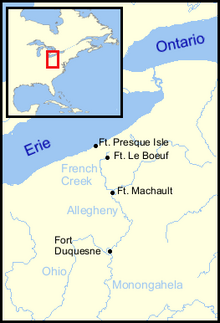Fort Le Boeuf

Fort Le Boeuf , French Fort de la Rivière au Bœuf, was a French fortress south of Lake Erie in the 18th century .
Location and function
The fort was about 15 miles from the lake in the area of what is now Waterford in northwestern Pennsylvania , which at the time belonged to New France . A chain of four fortifications was supposed to secure the French territory against the English colony to the east. It consisted of Fort Presque Isle directly on the lake, Fort Le Boeuf, Fort Machault and Fort Duquesne at the confluence of Monongahela and Allegheny . It owes its name to its location on the banks of the LeBoeuf , a tributary of the French Creek .
The fort protected the southern end of the supply route from the lake to the river. The French occupiers transported goods and supplies from the lake to the fort. From there they transported the goods by raft or canoe down French Creek to Allegheny, Ohio and Mississippi . The fort served as a garrison and trading post until 1759, when the fall of Fort Niagara forced France to abandon the Ohio area .
Today the Fort LeBoeuf Museum is located there .
history
The beginnings
Capitaine Paul Marin de la Malgue began construction on July 11, 1753. On December 3, 1753, Jacques Legardeur de Saint-Pierre took command of the first garrison. The English trading post at Venango at the mouth of the French Creek was captured and occupied. Over the winter, the French command left a guard at the new post and withdrew to Canada.
George Washington's assignment
Robert Dinwiddie , the governor of Virginia , responded to this advance by demanding that the French leave the Ohio area. With an escort of seven men, he sent the 21-year-old George Washington to Fort Le Boeuf to deliver them. Washington took Christopher Gist as a guide. During the march, Gist saved Washington's life twice. On December 11, 1753, Washington and Gist arrived at Fort Le Boeuf. The commandant Jacques Legardeur de Saint-Pierre, a seasoned veteran, received the delegation politely. He allowed Washington to stay at the fort for three days and finally sent him back with the answer that the Governor of Virginia should bring his request to the Major General of New France in the capital Quebec .
Washington noted that the fort had a crew of 100 during his stay, including many officers. It had 50 birch bark and 70 spruce canoes, many of which were unfinished. He described that the fort was almost completely surrounded by the stream. The fortifications consisted of palisades more than twelve feet high; the wooden posts were pointed at the top. Larger loopholes for cannons and smaller ones for rifles have been cut out of the walls. Eight six-pounder cannons and one four-pounder cannon protected the gate. Inside the fortress were a guard house, a chapel, a doctor's office and the commandant's rooms. Outside the fort there were several wooden barracks, some with bark, others with boards. There were also stables, a smithy and other buildings.
Seven Years War in North America
The Seven Years War began with the battle of Jumonville Glen in May 1754 . Five years later, in July 1759, the French Fort Niagara surrendered. The following month, the Fort Presque Isle commander ordered forts Machault and Le Boeuf to relinquish their positions. After the French withdrew, the British occupied the posts. It is possible that the French burned down Fort Le Boeuf before they withdrew. If that happened, the British would rebuild it.
During the Pontiac Uprising in June 1763, a group of Indians burned down Fort Le Boeuf. The survivors fled to Fort Venango . When this was also burned down, they continued their escape to Fort Pitt .
In August 1794, Major Ebenezer Denny, in a letter to Governor Thomas Mifflin, described Le Boeuf as a fort with four log houses and a crew of riflemen. There was a six-pounder cannon in each of the two rear log houses on the upper floor. The gates were protected by pivoting cannons. When the judge Vincent settled in Waterford in 1797, he wrote that apart from traces on the ground there were no remains of the old French fortress.
Individual evidence
- ↑ Fort LeBoeuf Historical Marker. In: http://explorepahistory.com . 2019, accessed on March 12, 2021 .
- ↑ Fort LeBoeuf Historical Society: Fort Leboeuf Museum. In: http://fortleboeufhistory.com/ . Accessed March 11, 2021 .
- ↑ David Clary: George Washington's First War . Simon & Schuster, New York 2011, ISBN 978-1-4391-8110-2 , pp. xix .
- ^ Fort Necessity - National Battlefield. In: http://www.nps.gov . National Park Service, archived from the original on August 14, 2007 ; accessed on March 12, 2021 (English).
- ^ W. Eccles: The French in North America: 1500-1783 . Fitzhenry & Whiteside, 2010, ISBN 978-1-55455-166-8 , pp. 181 .
- ↑ Jacques Lacoursière, Hélène-Andrée Bizier: Nos racines: l'histoire vivante des Québécois . Éditions Transmo, Saint Laurent 1979, p. 457 (French).
- ↑ George Washington: The Journal of Major George Washington, of His Journey to the French Forces on Ohio . 1754 (quoted from George Dallas Albert: The Frontier Forts of Western Pennsylvania).
literature
- George Dallas Albert: The Frontier Forts of Western Pennsylvania . CM Busch, state printer, Harrisburg 1896 (The drawing on page 556a shows Fort Le Boeuf at the junction of Water Street and High Street. Caption: "Fort Le Boeuf built by the French in 1753 Burned in 1763." Washington's description of the fort on Page 572. Further descriptions of the fort on pp. 566 - 581).
- Charles Morse Stotz: Outposts Of The War For Empire: The French And English In Western Pennsylvania: Their Armies, Their Forts, Their People 1749-1764 . University of Pittsburgh Press, Pittsburgh 2005, ISBN 0-8229-4262-3 .
Coordinates: 41 ° 56'22.2 " N , 79 ° 58'56.8" W.
